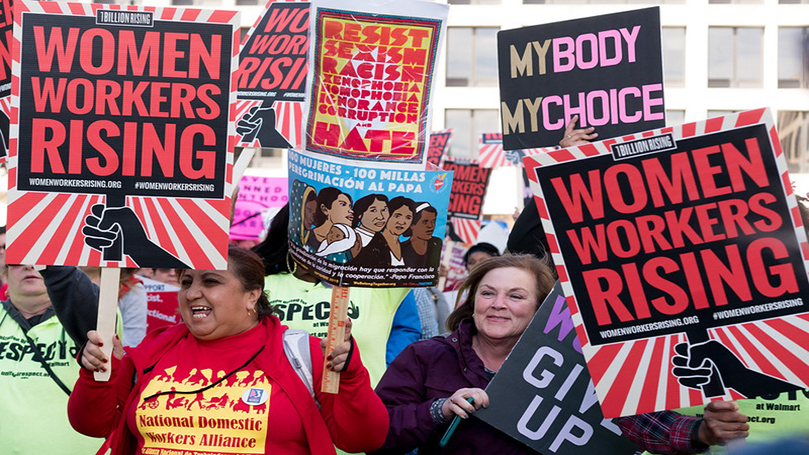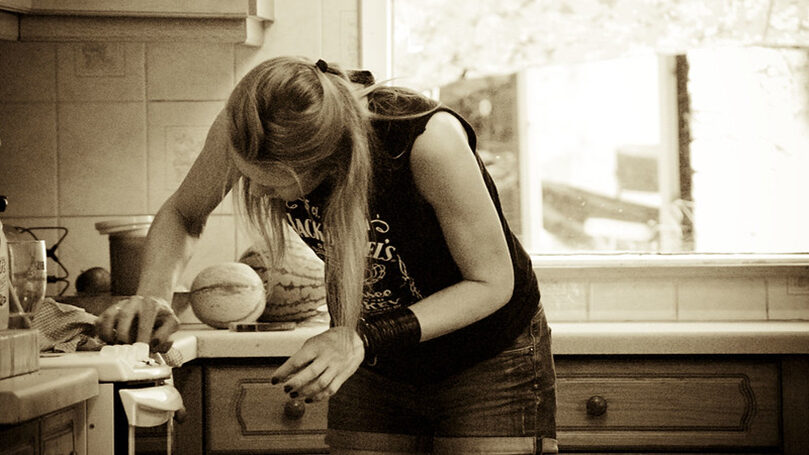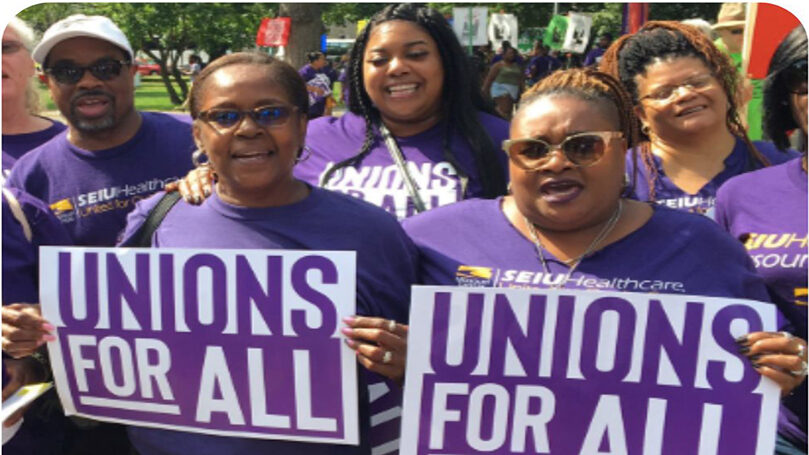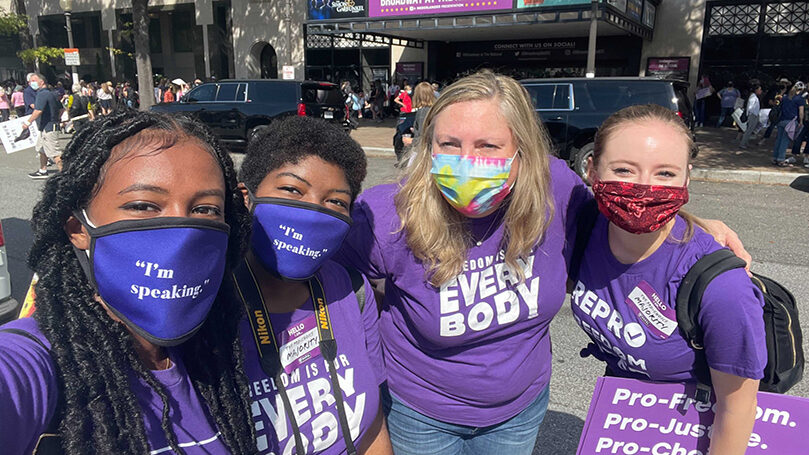
What can the Party do to increase participation and leadership of women in the struggle for socialism?
Here’s a practical solution: work to create an environment where women are accommodated and included in all areas of political work. This includes providing free childcare at events, promoting women into leadership, assigning traditionally “female” tasks (such as cleanup, mediation, cooking, and other forms of care work) to men, and making special efforts to recruit working-class women, particularly women of color and mothers. This proposed environment also requires challenging and struggling against patriarchal and transphobic attitudes so that women are not only safe, but enthusiastically welcome in our ranks.
These steps are simple and uncontroversial, but while the Party’s membership numbers are up, a gender gap still exists between men and everyone else who wants to join the Party. Instead of throwing around blame or becoming frustrated, we might instead ask ourselves why the present situation exists and what could be done to pull us out of it.
A Communist organizer does not bully and yell to get work done. This is how bourgeois political campaign work is done, not proletarian organizing. Workers ask political questions and require political explanations. If we do not understand for ourselves the paramount importance of the gender question, the work will not proceed. Simply telling comrades to “include more women” or “provide childcare” will result in half-hearted efforts laced with resentment, and often this work will fall by the wayside as a result. Recruiting, mentoring, and elevating working-class women as a priority often takes a back seat to others — the question is why?
Women make up at least half of the working-class population. Numerically speaking, gender is the largest wedge lodged in the working class to keep it from uniting. Often, employers will intentionally hire women for certain kinds of work and men for other kinds of work. This separates them into two separate camps and prevents the bargaining unit from coming together. Management’s unwillingness to combat sexual harassment or bullying on the job sows deep distrust between men and women — that’s intentional and one of the reasons that building power on the job is so critical for not just workers, but also women’s liberation. But does this divide necessarily originate in the workplace, and is waged labor our only site of struggle?
The personal is not just political, but also economic
The economy can be separated into two main spheres: the productive and social reproductive spheres. In the productive sphere, goods and services are made by waged labor to sell, while in the social reproductive sphere, workers are born, raised, and cared for with unpaid labor.
In the productive sphere, we encounter working women who toil alongside men to produce surplus value for the boss in exchange for a wage. Even though the pay gap between men and women has narrowed in the past decades, this is not necessarily because women are earning more but because all workers are earning less. The gap narrowed from 67% to 85% between 1980 and 2019. However, in 2018 adjusted dollars, the average hourly wage for workers increased only from about $21 to $22 per hour.
Some say that women make less than men because they often drop out of the workforce once they have children, or they are more likely to take on part-time work. Indeed, while 68% of men are counted as part of the labor force, only 56% of women are included.
This is because, while women are working in the productive sphere of the economy, they are also working unpaid in the reproductive sphere. Women between the ages of 25 and 34 spend an average 8.5 hours per day on unpaid household labor and care work, almost double the time that men spend on unpaid household labor and care work, 4.5 hours per day. This gap exists across all ethnicities, especially with Hispanic and Asian women. Simply put: women on average have four hours less per day to dedicate to political work as compared to men, who have more opportunities to be involved precisely because women are expected to do more unwaged work in the reproductive sphere than men.

Because women are paid less at work and are not paid for work inside the home, this means they are less able to save for retirement and more likely to fall into poverty at every stage of life. According to the book Invisible Women: Data Bias in a World Designed for Men by Caroline Criado Pérez, a Black woman would need to work until the age of 84 to match the earnings of a 60-year-old white man, and Latinas would need to work until they were 93.
Indeed, women across demographics are 35% more likely than men to live in poverty. According to the U.S. Census, 26% of women who live alone are below the poverty line, more than double the rate of men (12%). Shockingly, 42% of single mothers are in poverty compared to 18% of single fathers.
This is only one part of the story of why women are less likely to be involved politically. Women’s economic well-being is often tied to their role as primary laborer in a male-dominated household. Their difficulty in leaving abusive relationships is connected not only to their economic inability to do so, but also to a society that views them first and foremost as a caregiver and relegates the major site of their oppression — the interpersonal or reproductive sphere — as “private” and “personal.” Perhaps this is why the Violence Against Women Act (VAWA) has not been renewed since Trump let it lapse in 2019, defunding women’s shelters and health clinics across the United States. Meanwhile, women are forced to survive in private, personal realms of terror in a country where more than half of women who are murdered were killed by their husbands or boyfriends.
To say that the personal is not political is to accept the gender gap in our political work. These issues — gender-based violence, unpaid work, poverty, and single parenting — are issues that directly impact the reproductive sphere of the economy. They are the cultural foundations for male supremacy and serious barriers to women becoming more involved in organizing: not only are women less able to participate due to time, money, and safety concerns, but men unconsciously bring chauvinist attitudes forged in the reproductive sphere into our organizing spaces.
A sound strategy for working-class unity acknowledges the importance of the gender question
Clubs and districts might not worry about childcare at their events because either they are excluding mothers from their ranks or they are indirectly offloading this work onto women who are absent from these spaces. The lack of comradely socialization between genders results in patriarchal environments. If women are seen first and foremost as care workers and possible mates, they are unable to work closely with comrades and will become disillusioned. Women may have children, decide they are unable to keep up with Party work, and then drift away. Why make a special effort to keep them around?
First, by excluding women, we are depriving ourselves of half our strength. This does not just mean a 50% reduction in our numbers at rallies, but also a 50% reduction of skilled comrades who might otherwise be able to contribute to the strategic, theoretical, and organizational work of the Party.
Second, women’s oppression is the societal backbone of the reproductive sector of the economy. From there it radiates to all culture and into all aspects of a woman’s life, whether she is married with children or not. Without struggling for equity across all workplaces, including the home, we will be limited in what we can accomplish. It is difficult to build shop unity while one section of the bargaining unit is being exploited by the other after the workday is over.

Third, the fascist threat finds a safe home in patriarchal violence and oppression. The extreme right is motivated by cries of preserving so-called traditional families and the hatred of women. Donald Trump made no secret of his loathing and contempt. The GOP attacks on trans children and women’s reproductive rights are obvious strategies to stoke misogyny. The fascist threat offers men tyrannical control over the social reproductive sphere in lieu of proletarian democracy on the shop floor. Meanwhile, fascism cynically offers women food and security if only we would submit ourselves to patriarchal control.
As Dimitrov writes:
While fascism exacts most from youth it enslaves women with particular ruthlessness and cynicism, playing on the most painful feelings of the mother, the housewife, the single working woman, uncertain of the morrow. Fascism, posing as a benefactor, throws the starving family a few beggarly scraps, trying in this way to stifle the bitterness aroused particularly among the toiling women, by the unprecedented slavery which fascism brings them. We must spare no pains to see that the women workers and toilers fight shoulder to shoulder with their class brothers in the ranks of the united working class front and the anti-fascist people’s front.
Instead of opposing patriarchy for moral reasons, we should deepen our understanding that if we do not make efforts to include all women in all sectors of work and leadership, we cut our forces in half, deepen divisions in shop organizing, and provide a soft underbelly for fascist forces to attack.
Building unity between women
What of the need to build unity across all demographics of women? Why is a white woman’s liberation contingent on fighting on behalf of, for example, her Black trans sister’s right to exist?
As Claudia Jones wrote, “The exploitation of women cuts across class lines and affects all women.” As racism is used to divide the productive sphere, so too is it used to divide women in the reproductive sphere. Without building unity between all women as women, we cannot organize our homes and will therefore be unable to organize our workplaces.
One of the more relevant divisions mentioned briefly earlier is the far-right attacks being levied against trans people, particularly women. Like the backlash against gay marriage, accepting trans women as women throws an already-fragile masculinity into crisis. If there is no biological basis for gender, that is, if someone of one sex can be of any gender, the whole rationale of why families exist, and why women are oppressed — that is, to bear and raise children and take care of men — falls apart. We see patriarchal capitalism for what it really is: a cynical arrangement where one section of the working class is pitted against another to enable and reinforce the capitalist exploitation of all workers.

While issues of abortion access, wage gaps, poverty, and safety affect all women, they affect some women more than others. Women are not simply oppressed as women; they experience multiple, intersectional oppressions as Black women, indigenous women, poor women, old women, and other forms of intersectional oppression. This is what makes the struggle against racism, transphobia, and other forms of oppression so key to building a proletarian women’s movement.
Yet, the work of building unity among women is not something that men can lead — women must do this work. For this to happen, men must welcome women from all sectors of society by taking up the tasks mentioned at the beginning of this essay: providing childcare, taking up more “feminized” tasks to enable women and non-binary people to engage in other areas of work and leadership, and also to struggle against their own chauvinism. This requires, first and foremost, a political understanding of why women’s liberation is paramount to their liberation not only as women but primarily as workers.
Integrating the reproductive sphere into Party work
It makes sense that the Young Pioneers of America (YPA) was most active at the height of the Party’s influence and membership. More than 12,000 children joined the YPA between the ages of 8 and 15 before moving on to joining the Young Communist League. The YPA was not just a summer camp or after-school program — though the YPA offered both — but also a way of reorganizing the social reproductive sphere as part of a strategy to organize all workers, including women.
YPA children organized for free lunches, books, clothing, and transportation. They offered an alternative to the Boy Scouts of America and engaged children in outdoor exploration and play, art, music, theater, community work, and political education. This was not only a means of lessening the burden of women at home; it also was a powerful tool to create real proletarian communities. After all, many of those 12,000 YPA children grew up to become active in the struggle for civil rights, women’s liberation, and against imperialist war.
As a famous proverb goes: a child does not grow up only in a single home. Under capitalism, we are encouraged to think of the patriarchal home as the primary site of social reproduction, something private and unrelated to a larger struggle for economic and political liberation. This narrow view cuts us off from our neighbors, coworkers, and comrades and prevents building broader working-class unity. It is only by thoroughly studying and struggling against patriarchy that we can hope to reclaim the terrain of social reproduction as a party and formulate an approach as revolutionary as demanding that workers own the means of production. Social reproduction is not a private affair; it is a key site of struggle for worker power. Therefore, women’s liberation is key to proletarian victory.
Images: Women Workers Rising rally, Victoria Pickering (CC BY-NC-ND 2.0); Woman cleaning, Jason Jones (CC BY-NC-SA 2.0); Unions for All, SEIU (Facebook); Women at pro-choice rally, NARAL (Facebook).


 Join Now
Join Now